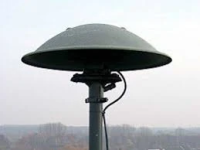E57
| Einheitssirene 1957 (E57) | |

| |
| Company | Multiple companies produced this siren. |
|---|---|
| Produced | 1957-1992 |
| Type | Omnidirectional Electromechanical |
| Horsepower | 5.3-6.7 hp (4-5 kW) |
| Voltage | 220 V 3 ph |
The Standard Siren 1957 (German: Einheitssirene 1957, abbreviated E57), also named the Air Protection Siren 1957 (German: Luftschutzsirene 1957, abbreviated L57) is a simple medium-range omnidirectional siren. It superseded the earlier Air Protection Siren 1952 (German: Luftschutzsirene 1952, abbreviated L52) as the German "standard siren" and was produced from its introduction in 1957 until its eventual discontinuation in 1992. The E57 is, without a doubt, one of the most well-known German sirens, and it has maintained this status even more than 30 years later after its discontinuation. Thanks to its basic yet rugged design, it was widely installed throughout Germany and exported to various other nations. The E57 also served other purposes both during and after its production run, often used as an alarm to alert the fire brigade. The E57 spawned a countless number of imitators, such as the East German VEM DS977 and the Greek VILMA Motors NEVA/VILMA 55, and its design's influence can be found throughout Europe.
History and Design
In the mid-1950s, the West German government, in collaboration with Elektror, Siemens, and Helin, began to draft a brand-new standard siren which would offer superior performance and longevity compared to the sirens produced at the time. This came about after the recent division of Germany and fear of an imminent attack brought about by the Eastern Bloc. This development was primarily headed by Elektror who had earlier created the L141/L52, which the new siren would take inspiration from. This project ultimately resulted in the creation of the E57, named after the German Institute for Standardization (German: Deutsches Institut für Normung, abbreviated DIN)'s DIN 41096 standardization order. The E57 was designed as a relatively maintenance free siren which prioritized a longer life span rather than sound output. The E57 consists of a 9-port rotor and stator, with a grille carried over from the L52 protecting debris from entering the siren. The rotor on the E57 had thicker walls than that of the L52s, slightly improving the siren's range. A flange below the stator directs the siren's sound downwards and outwards, and has a rotation arrow cast on, which displayed the correct way the rotor was supposed to spin. This arrow was also present on the L52 but was instead cast on to the motor.
The E57 is powered by a 220/230/380/400 V 5 kW (6.7 hp) asynchronous 3 ph electric motor underneath the stator driving the rotor at around 2800 rpm, brought up to this speed around 2-4 seconds after activation. The motor shaft's countersink is rounded on the E57, whereas the L52's was square. The E57 lacks protective conductor connections of any kind, unlike its predecessor; this was likely a casualty of making the siren as simple as possible to produce and install. Like the L52, the E57 was designed for inexpensiveness and mass-producibility. It achieved this through several means; Its most notable feature, the large protective roof shielding the siren from the elements, is constructed out of fiberglass reinforced plastic instead of steel, contributing to a less costly siren. This also makes the siren lighter overall and prevents the roof from warping and being dented, as can be seen on many L141/L52 units. Additionally, the E57's mounting holes for the roof, located above the stator ports, sit level with the stator, as opposed to the ones of the L52 which were recessed into it. The holes drilled into the stator used for attaching the grille in place on the L141 are not present on the E57, simplifying its production further. A triangular base borrowed from the siren's predecessor, with 3 holes in each corned, allows the E57 to be bolted to a flat surface. A tripod and simple pole roof mount designs were available to purchase with the E57, and it could also be mounted to a tall steel pole. The flanges on the sides of the motor that connect it to the base of the siren were made straight on the E57, compared to the L52 where they were curved.
The E57 was officially put into production in 1960 after being finalized in 1957, with the 1st units going up sometime in 1959.
The E57 was formally discontinued in 1992 after the end of the Cold War. After Germany's civil defense division was abolished, the ownership of these sirens turned to the municipalities of which they were installed in.
WIP
References